|
Introduction to Flow Meters
What is a flow meter? 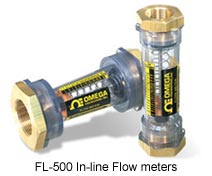 A flowmeter is an instrument used to measure linear, nonlinear, mass or volumetric flow rate of a liquid or a gas. A flowmeter is an instrument used to measure linear, nonlinear, mass or volumetric flow rate of a liquid or a gas.
Selecting a Flow Meter
The basis of good flowmeter selection is a clear understanding of the requirements of the particular application. Therefore, time should be invested in fully evaluating the nature of the process fluid and of the overall installation.
Here are some key questions which need to answered before selecting a flowmeter:
The basis of good flow meter selection is a clear understanding of the requirements of the particular application. Therefore, time should be invested in fully evaluating the nature of the process fluid and of the overall installation. The first step in flow sensor selection is to determine if the flowrate information should be continuous or totalized, and whether this information is needed locally or remotely. If remotely, should the transmission be analog, digital, or shared? And, if shared, what is the required (minimum) data-update frequency? Once these questions are answered, an evaluation of the properties and flow characteristics of the process fluid, and of the piping that will accommodate the flowmeter, should take place. In order to approach this task in a systematic manner, forms have been developed, requiring that the following types of data be filled in for each application: Click here to download the Flowmeter Evaluation Form Fluid and flow characteristics: In this section of the table, the name of the fluid is given and its pressure, temperature, allowable pressure drop, density (or specific gravity), conductivity, viscosity (Newtonian or not?) and vapor pressure at maximum operating temperature are listed, together with an indication of how these properties might vary or interact. In addition, all safety or toxicity information should be provided, together with detailed data on the fluid's composition, presence of bubbles, solids (abrasive or soft, size of particles, fibers), tendency to coat, and light transmission qualities (opaque, translucent or transparent?). Expected minimum and maximum pressure and temperature values should be given in addition to the normal operating values when selecting flowmeters. Whether flow can reverse, whether it does not always fill the pipe, whether slug flow can develop (air-solids-liquid), whether aeration or pulsation is likely, whether sudden temperature changes can occur, or whether special precautions are needed during cleaning and maintenance, these facts, too, should be stated.
Concerning the piping and the area where the flowmeters are to be located, consider: The specifying engineer must know if vibration or magnetic fields are present or possible in the area, if electric or pneumatic power is available, if the area is classified for explosion hazards, or if there are other special requirements such as compliance with sanitary or clean-in-place (CIP) regulations. The next step is to determine the required meter range by identifying minimum and maximum flows (mass or volumetric) that will be measured. After that, the required flow measurement accuracy is determined. Typically accuracy is specified in percentage of actual reading (AR), in percentage of calibrated span (CS), or in percentage of full scale (FS) units. The accuracy requirements should be separately stated at minimum, normal, and maximum flowrates. Unless you know these requirements, your flowmeter's performance may not be acceptable over its full range. In applications where products are sold or purchased on the basis of a meter reading, absolute accuracy is critical. In other applications, repeatability may be more important than absolute accuracy. Therefore, it is advisable to establish separately the accuracy and repeatability requirements of each application and to state both in the specifications. When a flowmeter's accuracy is stated in % CS or % FS units, its absolute error will rise as the measured flow rate drops. If meter error is stated in % AR, the error in absolute terms stays the same at high or low flows. Because full scale (FS) is always a larger quantity than the calibrated span (CS), a sensor with a % FS performance will always have a larger error than one with the same % CS specification. Therefore, in order to compare all bids fairly, it is advisable to convert all quoted error statements into the same % AR units. In well-prepared flow meter specifications, all accuracy statements are converted into uniform % AR units and these % AR requirements are specified separately for minimum, normal, and maximum flows. All flowmeters specifications and bids should clearly state both the accuracy and the repeatability of the meter at minimum, normal, and maximum flows. If acceptable metering performance can be obtained from two different flow meter categories and one has no moving parts, select the one without moving parts. Moving parts are a potential source of problems, not only for the obvious reasons of wear, lubrication, and sensitivity to coating, but also because moving parts require clearance spaces that sometimes introduce "slippage" into the flow being measured. Even with well maintained and calibrated meters, this unmeasured flow varies with changes in fluid viscosity and temperature. Changes in temperature also change the internal dimensions of the meter and require compensation.
Furthermore, if one can obtain the same performance from both a full flowmeter and a point sensor, it is generally advisable to use the flowmeter. Because point sensors do not look at the full flow, they read accurately only if they are inserted to a depth where the flow velocity is the average of the velocity profile across the pipe. Even if this point is carefully determined at the time of calibration, it is not likely to remain unaltered, since velocity profiles change with flowrate, viscosity, temperature, and other factors. Before specifying a flow meter, it is also advisable to determine whether the flow information will be more useful if presented in mass or volumetric units. When measuring the flow of compressible materials, volumetric flow is not very meaningful unless density (and sometimes also viscosity) is constant. When the velocity (volumetric flow) of incompressible liquids is measured, the presence of suspended bubbles will cause error; therefore, air and gas must be removed before the fluid reaches the meter. In other velocity sensors, pipe liners can cause problems (ultrasonic), or the meter may stop functioning if the Reynolds number is too low (in vortex shedding meters, RD > 20,000 is required). In view of these considerations, mass flowmeters, which are insensitive to density, pressure and viscosity variations and are not affected by changes in the Reynolds number, should be kept in mind. Also underutilized in the chemical industry are the various flumes that can measure flow in partially full pipes and can pass large floating or settleable solids. |
| Flowmeter Types | |
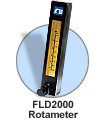 |
Rotameter or Variable Area Flowmeter for Gases and Liquids The rotameter is a tapered tube and a float. It is the most widely used variable-area flow meter because of its low cost, simplicity, low pressure drop, relatively wide rangeability, and linear output. For a complete listing of Rotameters click on the image to the left. |
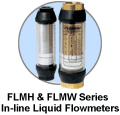 |
More Variable Flowmeters: Spring and Piston Flow Meters for Gases and Liquids Piston-type flowmeters use an annular orifice formed by a piston and a tapered cone. The piston is held in place at the base of the cone (in the "no flow position") by a calibrated spring. Scales are based on specific gravities of 0.84 for oil meters, and 1.0 for water meters. Their simplicity of design and the ease with which they can be equipped to transmit electrical signals has made them an economical alternative to rotameters for flowrate indication and control.For a complete listing of Spring and Piston flow meters, click on the image to the left. |
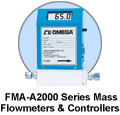 |
Mass Gas Flowmeters Thermal-type mass flow meters operate with minor dependence on density, pressure, and fluid viscosity. This style of flowmeter utilizes either a differential pressure transducer and temperature sensor or a heated sensing element and thermodynamic heat conduction principles to determine the true mass flow rate. Many of these mass flowmeters have integral displays and analog outputs for data logging. Popular applications include leak testing and low flow measurements in the milliliters per minute. For a complete listing of Mass Flowmeters click on the image at left. |
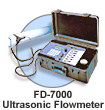 |
Ultrasonic Flowmeters (Non-Intrusive or Doppler) for Liquids The ultrasonic doppler flow meters are commonly used in dirty applications such as wastewater and other dirty fluids and slurries which ordinarily cause damage to conventional sensors. The basic principle of operation employs the frequency shift (Doppler Effect) of an ultrasonic signal when it is reflected by suspended particles or gas bubbles (discontinuities) in motion. For a complete listing of Ultrasonic Flowmeters click on the image at left. |
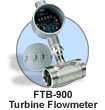 |
Turbine Flow meters The turbine meter can have an accuracy of 0.5% of the reading. It is a very accurate meter and can be used for clean liquids and viscous liquids up to 100 centistokes. A minimum of 10 pipe diameters of straight pipe on the inlet is required. The most common outputs are a sine wave or squarewave frequency but signal conditioners can be mounted on top for analog outputs and explosion proof classifications. The meters consists of a multi-bladed rotor mounted at right angles to the flow and suspended in the fluid stream on a free-running bearing. For a complete listing of Turbine Flowmeters click on the image at left. |
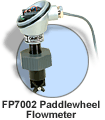 |
Paddlewheel Sensors One of the most popular cost effective flowmeters for water or water like fluids. Many are offered with flow flittings or insertions styles. These meters like the turbine meter require a minimum of 10 pipe diameters of straight pipe on the inlet and 5 on the outlet. Chemical compatibility should be verified when not using water. Sine wave and Squarewave pulse outputs are typical but transmitters are available for integral or panel mounting. The rotor of the paddlewheel sensor is perpendicular to the flow and contact only a limited cross section of the flow. For a complete listing of Paddlewheel Flowmeters click on the image at left. |
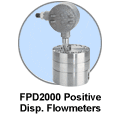 |
Positive Displacement Flowmeters These meters are used for water applications when no straight pipe is available and turbine meters and paddlewheel sensor would see too much turbulence. The positive displacement are also used for viscous liquids. For a complete listing of Positive Displacement Flowmeters click on the image at left. |
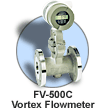 |
Vortex Meters The main advantages of vortex meters are their low sensitivity to variations in process conditions and low wear relative to orifices or turbine meters. Also, initial and maintenance costs are low. For these reasons, they have been gaining wider acceptance among users. Vortex meters do require sizing, contact our flow engineering. For a complete listing of Vortex Flowmeters click on the image at left. |
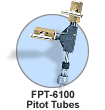 |
Pitot Tubes or Differential Pressure Sensor for Liquids and Gases The pitot tubes offer the following advantages easy, low-cost installation, much lower permanent pressure loss, low maintenance and good resistance to wear. The pitot tubes do require sizing, contact our flow engineering. For a complete listing of Pitot Tube Flowmeters click on the image at left. |
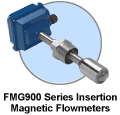 |
Magnetic Flow meters for Conductive Liquids Available in in-line or insertion style. The magnetic flowmeters do not have any moving parts and are ideal for wastewater application or any dirty liquid which is conductive. Displays are integral or an analog output can be used for remote monitoring or data logging. For a complete listing of Magnetic Flowmeters click on the image at left. |
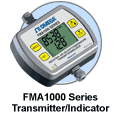 |
Anemometers for Air Flow Measurement Hot wire anemometers are probes with no moving parts. Airflow can be measured in pipes and ducts with a hand held or permanent mount style. Vane anemometers are also available. Vane anemometers are usually larger than a hot wire but are more rugged and economical. Models are available with temperature and humidity measurement. For a complete listing of Air Flowmeters or Anemometers click on the image at left. |
| Flowmeters In General |
